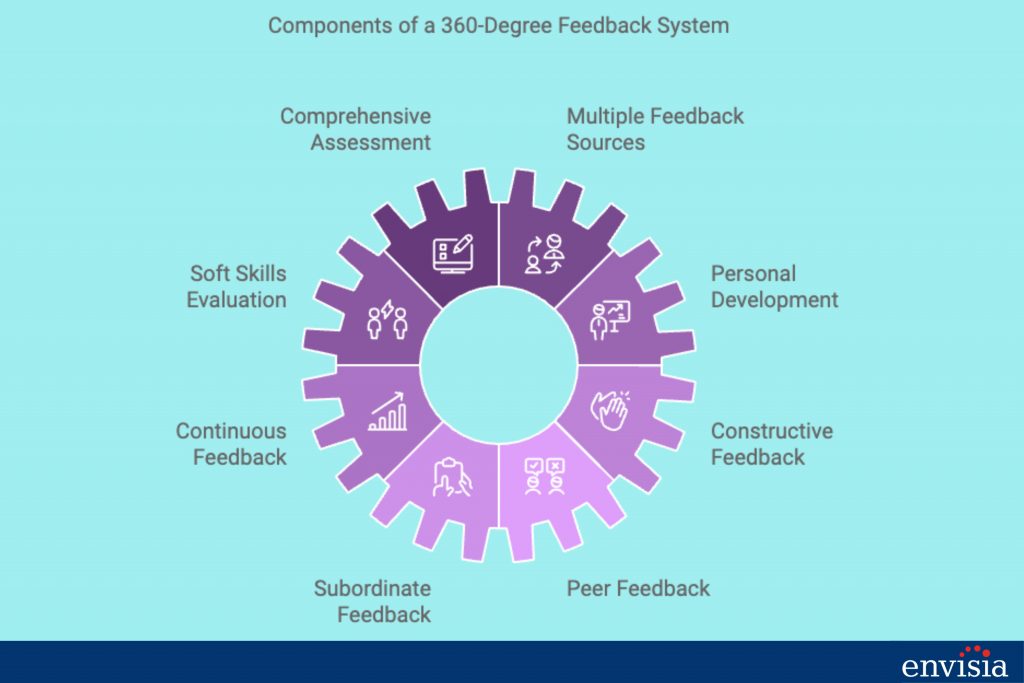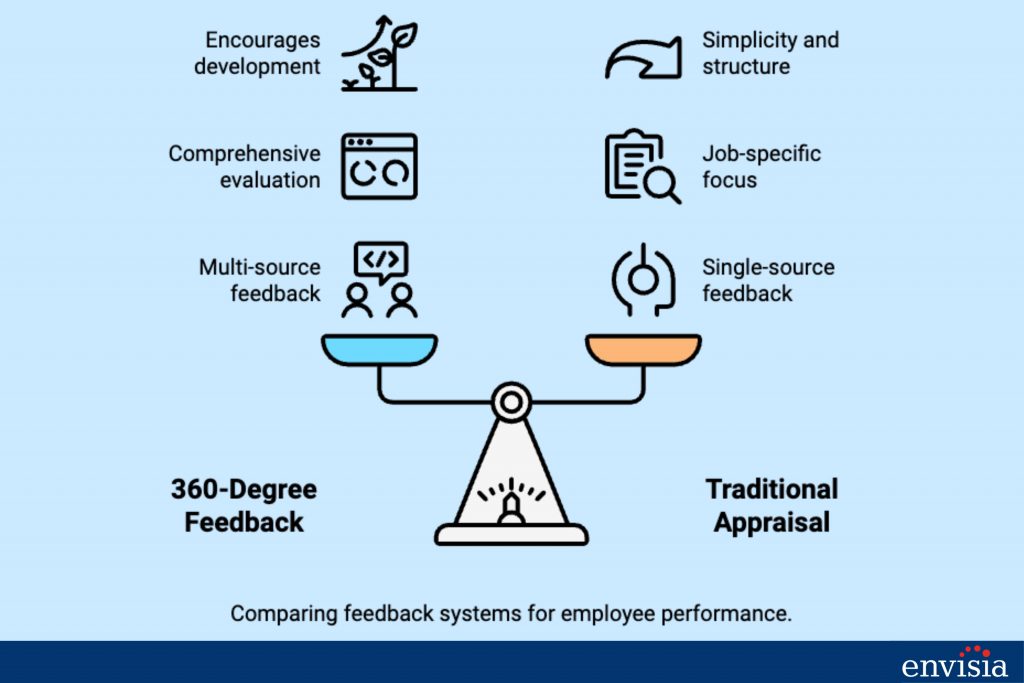Navigating performance evaluations can often feel overwhelming for both managers and employees. Traditional performance reviews sometimes leave us feeling unheard, unappreciated, or unclear about our growth paths.
These conventional methods may not capture the full spectrum of an employee’s contributions and potential, leading to missed opportunities for development and engagement. But what if there was a way to receive feedback that paints a holistic picture of your performance?
In this article, we’ll explore the differences between traditional performance appraisals and the 360-degree feedback system, shedding light on how embracing a more comprehensive approach can foster personal growth and enhance organizational success.
Key Takeaways
- Understanding the 360-Degree Feedback System: Learn how gathering feedback from multiple sources provides a more comprehensive evaluation of employee performance.
- Comparing Feedback Approaches: Discover the key differences between 360-degree feedback and traditional performance reviews, and how each impacts performance management.
- Choosing the Right System for Your Organization: Find out how to select the feedback system that best suits your team’s needs and fosters continuous development.

What is a 360-Degree Feedback System
Understanding the 360-Degree Feedback Approach
In a 360-degree feedback system, employees get feedback from a wider circle of colleagues, including managers, peers, direct reports, and sometimes even clients or stakeholders. This multi-rater feedback method offers a holistic view of an employee’s performance by incorporating diverse perspectives. Unlike traditional reviews that rely solely on a manager’s evaluation, the 360-degree feedback process gathers feedback from various sources, ensuring that employees get a more comprehensive understanding of their strengths and areas for improvement.
This approach not only helps in evaluating employee performance more effectively but also promotes self-awareness and personal development. By receiving feedback from multiple sources, employees can identify blind spots and leverage their strengths in different contexts within the organization. The 360-degree feedback involves input from those who interact with the employee regularly, providing a richer, more nuanced picture of their performance and competencies.

Key Features of a 360-Degree Feedback System
One of the standout features of the 360-degree review is its ability to provide a more comprehensive assessment of an employee’s competencies. By gathering feedback from several sources, this feedback system evaluates not just job-specific tasks but also essential soft skills like leadership, communication, and collaboration. This type of feedback is invaluable for personal development because it highlights how an employee’s actions impact others across different levels of the organization.
Moreover, the 360 review process encourages continuous feedback, fostering an environment where employees feel supported in their growth journeys. The approach ensures that the constructive feedback gained often includes insights that might be overlooked in traditional performance evaluations. By incorporating subordinate and peer feedback, organizations can ensure that feedback effectively addresses all areas of an employee’s performance.
What is a Traditional Performance Appraisal
Structure of Traditional Performance Reviews
Traditional performance appraisals are the cornerstone of many organizations’ performance management strategies. In this appraisal system, the review process is typically a top-down approach where managers or supervisors, solely, deliver feedback. This method of evaluating employee performance focuses on predefined goals and job-specific tasks, often culminating in an annual or semi-annual performance review.
While this approach can be simpler to administer, it may not capture the full spectrum of an employee’s contributions. Because the feedback comes from a single source, there’s a potential for bias and important insights from peers or direct reports might be overlooked. As a result, employees might not receive the comprehensive feedback necessary for holistic development.
Characteristics of a Traditional Performance Appraisal System
Traditional (classic) performance appraisal systems often emphasize evaluating an employee’s performance based on predefined objectives and key performance indicators. The performance review is a process that usually occurs annually or semi-annually, focusing on past performance rather than future development. This approach tends to prioritize job-specific tasks and measurable outcomes, which can be beneficial for making decisions about promotions, salary adjustments, or other HR-related actions.
However, because traditional performance reviews may overlook softer skills like leadership or teamwork, they might not fully capture an employee’s potential or areas where they could grow. Additionally, the feedback loop in this system is typically limited, which can hinder continuous improvement and employee engagement.

Key Differences: 360 Degree Feedback vs Traditional Performance Appraisal
Feedback System: Multi-Source vs Single-Source
The most significant difference between traditional performance appraisals vs the 360-degree feedback system lies in the feedback mechanism itself. The 360-degree approach gathers feedback from multiple sources, including peers, direct reports, and sometimes even external stakeholders. This multi-source feedback provides a more comprehensive view of an employee’s performance, capturing diverse perspectives that a single evaluator might miss.
In contrast, traditional reviews rely solely on the manager’s assessment, which can be limited and potentially biased. By comparing these two approaches, it’s clear that 360 degree reviews can provide richer, more actionable insights compared to traditional methods.
Performance Evaluation Scope
When it comes to the scope of performance evaluation, 360 feedback stands out by evaluating a wider range of competencies. This method assesses not only technical skills but also interpersonal abilities like communication, leadership, and teamwork. Such an approach ensures that employees receive feedback on all aspects of their performance, promoting well-rounded development.
On the other hand, traditional performance reviews tend to focus on job-specific tasks and measurable outcomes. While this can be effective for assessing immediate job performance, it may not address areas crucial for long-term growth and collaboration within the team.
Pros and Cons of 360-Degree Feedback vs Traditional Performance Reviews

Pros of 360-Degree Feedback
Implementing 360-degree feedback offers numerous advantages for both individuals and organizations. By incorporating feedback from various sources, this approach provides a more comprehensive evaluation of an individual’s performance. Diversifying the feedback providers also reduces the likelihood of bias that can occur when evaluations come from a single manager. Employees receive a range of feedback that provides insights into how they are perceived across the organization, fostering greater self-awareness.
Moreover, the process encourages ongoing personal development. Employees are more engaged when they understand that their growth is supported by a comprehensive system that values input from peers, subordinates, and supervisors alike.
Cons of 360-Degree Feedback
Despite its benefits, the 360-degree feedback system also has its drawbacks. One of the cons of 360 feedback is that it can be time-consuming to collect feedback and analyze input from multiple providers. The feedback process requires coordination and commitment from all participants, which can strain resources, especially in larger organizations.
Additionally, receiving feedback from several sources may lead to conflicting opinions, making it challenging for employees to know which areas to focus on. Without proper guidance, the wealth of information can become overwhelming rather than helpful.

Pros of Traditional Performance Reviews
Traditional performance reviews offer simplicity and structure, making them an effective performance management tool for many organizations. This approach is easier to implement, especially for small teams where managers closely observe their employees’ performance. The straightforward nature of traditional reviews means that the review process is less time-consuming and can be more easily integrated into existing performance management strategies.
For organizations seeking a clear and direct method of evaluating employee performance, the conventional performance appraisal provides a familiar and manageable approach.
Cons of Traditional Performance Appraisals
However, the traditional performance appraisal has its limitations. Relying on feedback from a single source—usually the manager—can introduce bias and may not provide a complete picture of an employee’s performance. This downward feedback approach can overlook valuable insights from peers and direct reports, leading to gaps in the evaluation.
Furthermore, traditional annual reviews often focus on past performance without offering actionable steps for future growth. This lack of continuous feedback can hinder an employee’s development and reduce engagement over time.

How to Choose the Right Feedback System for Your Organization
When to Use a 360-Degree Feedback System
Selecting the appropriate feedback and development system depends on your organization’s specific needs and goals. A 360-degree feedback is a performance evaluation method best suited for environments that value collaboration, continuous improvement, and leadership development. If your organization aims to foster open feedback and comprehensive personal growth, implementing 360-degree feedback can provide significant benefits.
This approach is particularly effective when employees need to develop soft skills and when feedback from multiple stakeholders is essential for a complete assessment.
When to Use a Traditional Performance Appraisal System
Conversely, a traditional performance appraisal system may be more appropriate for organizations that prefer a straightforward, top-down approach. If your team is small or if roles are highly specialized with clear, measurable outcomes, the traditional performance review can be efficient and effective. This method simplifies the process and can be easier to manage without the need for gathering extensive feedback from various sources.
Ultimately, the decision between 360-degree feedback vs traditional performance reviews should align with your organization’s culture, resources, and development objectives.
Tools and Software for Effective 360-Degree Feedback and Traditional Performance Reviews
Choosing the Right Feedback Software
In today’s digital age, leveraging the right feedback software can streamline both 360-degree feedback and traditional performance reviews. These tools facilitate the collection, analysis, and delivery of feedback, making the process more efficient. When selecting a feedback tool, consider features that support your chosen method of evaluation, whether it’s gathering multi-source feedback for a 360 review or simplifying the appraisal process for traditional reviews.
Effective software should provide user-friendly interfaces, customizable questionnaires, and robust reporting capabilities to ensure that feedback is actionable and timely.
How to Provide Feedback Effectively Using Performance Systems
Regardless of the system you choose, it’s crucial to ensure that feedback is delivered effectively. When giving feedback, be specific and focus on observable behaviors and outcomes. Encourage a two-way dialogue where employees feel comfortable to give and receive feedback openly. Utilizing real-time feedback mechanisms within your performance management system can enhance engagement and prompt timely improvements.
Remember, the goal of any feedback process is not just to evaluate performance but to support continuous growth and development.

Conclusion: 360 Degree Feedback vs Traditional Performance Appraisal – Which is Best?
Choosing between using 360-degree feedback and traditional performance appraisals ultimately depends on your organization’s unique needs and objectives. While 360-degree feedback offers a more comprehensive, multi-dimensional view of employee performance, traditional performance reviews may suffice for smaller teams or roles with clearly defined tasks. By weighing the pros and cons of each approach, you can select a performance evaluation method that aligns with your organizational culture and supports your employees’ growth.
Remember, the most effective feedback system is one that not only evaluates performance but also fosters development, engagement, and continuous improvement.
